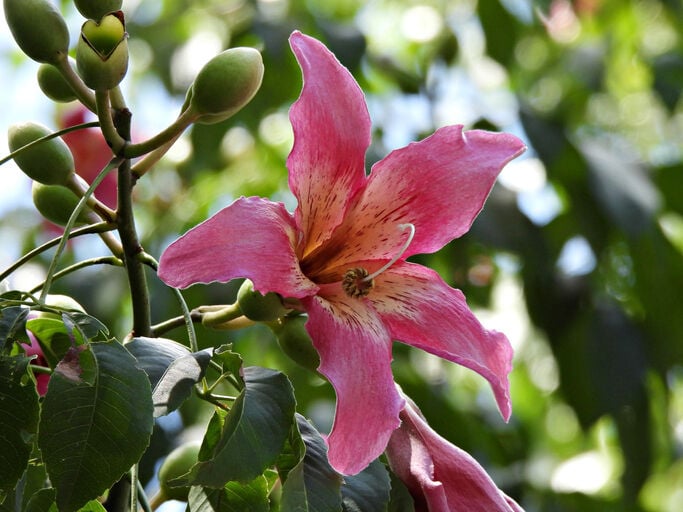If you’re in a warmer part of town, you may be tempted to try your hand at growing something tropical. While the folks in Phoenix have far less problems with tropical plants succumbing to frost, here in Tucson we do have occasional freezes which can kill tropical plants. However, if you’re prepared to protect your exotic charges from the vagaries of our desert climate, you can enjoy some unusual plants.
For many of these plants, the easiest option is to plant them in containers, where you can keep the soil rich and moist and control exposure to cold temperatures. However, if you have a warm, moist spot that is shady in the afternoons and has good-quality soil, you can try growing them in the ground. They will need regular soil amendments to stay happy.
Bananas (Musa acuminata and Musa balbisiana): I have managed to keep an apple banana plant in a large container alive for two years, so it’s definitely doable. It has yet to fruit, however. I have found it to be surprisingly resistant to cold weather; in fact the ‘Manzana’ cultivar is rated as USDA Zone 8A to 10. If you don’t care about fruit quality and don’t want to fuss with bringing a large plant in every time frost is forecast, try the Musa basjoo banana tree, which is hardy to USDA Zone 4! Bananas like acidic soil rich in nitrogen, so you will need to feed it. It needs afternoon shade in our climate. Keep bananas out of the wind, which will tear up their huge leaves and make your plant look drab and sad.
Pineapple (Ananas comosus): Pineapples are bromeliads, and can absorb some of their water and nutrients through their leaves. They do well in containers and need to be protected from frost. They can get pretty big; mine is currently in a 24-inch diameter pot. The easiest way to grow a pineapple is to root it from a pineapple top that you buy at your local grocery store. It will take a couple of years of steady growth before it produces its own pineapple. Don’t expect it to be the same size as your store-bought pineapple, but it will be very tasty. You can then root a new pineapple plant from the top of the one you just picked and ate.
Moringa (Moringa oleifera): This incredible tree is native to India and Bangladesh. It’s called the Tree of Life because every part of it is usable in some way. The leaves, roots and flowers can be eaten, the pods can be made into a nutritious powder, leaves can be dried and made into teas, and the oil in the pods can be used in various preparations and cosmetics. They are incredibly fast-growing, and some cultivators recommend simply cutting off the frost-killed branches each spring and allowing the plant to re-grow. They do best with mostly sun but afternoon shade and consistently moist rich soil.
Silk floss tree (Ceiba speciosa): These trees are considered safe to grow in USDA Zones 9-11. Mature trees should be fine down to 20 F but younger trees may not survive. They can grow 20-50 feet in height, so they aren’t candidates for containers. There is an example of this tree growing on the University of Arizona campus, so clearly it can survive here with some care. It likes full sun but needs a lot of water, particularly during our scorching summers. However, it will reward you with spectacular, huge, hot pink lilly-like flowers and a trunk shape right out of Dr. Seuss.
Hibiscus (Hibiscus rosa-sinensis): Despite their association with Hawaii, these plants do pretty well in Tucson. They are hardy to 20 F and in a warm, protected microclimate should reward you with nice growth. Their flowers range in color from pink to yellow to bright red, and (for me at least) are associated with the quintessential tropical landscape. Keep them out of direct afternoon sun, give them lots of fertilizer and organic matter, and keep the soil moist. They are water hogs, but their 3-inch blooms make it worthwhile. There are hardier varieties (Hibiscus moscheutos) which do well down to USDA Zone 5.
Dragon fruit (Hylocereus undatus): This cactus is native to Mexico, Central, and South America. It produces edible fruit, but only if it gets a fair amount of sun during the day. The difficulty comes during our hot summers, during which it prefers partial shade. It has a spreading habit so will need a lot of room if you plan to let it grow free. You can also try to trellis it, but you will need a strong structure to hold it up. It’s easy to propagate and somewhat drought-tolerant (compared to the other plants on this list) but still likes regular water.
Loquat (Eriobotrya japonica): This lovely evergreen tree is sub-tropical, and is hardy to as low as 15 F although it will probably lose flowers and fruit at these temperatures. It will not do well with afternoon sun and will need to be planted with morning sun and shade in the afternoon. It tolerates our soils better than other plants on this list, but does best with regular deep watering — particularly if you want fruit. It’s very sensitive to fertilizers, and only organic fertilizers should be used to avoid burning. The fruit can be eaten fresh or preserved or baked.





